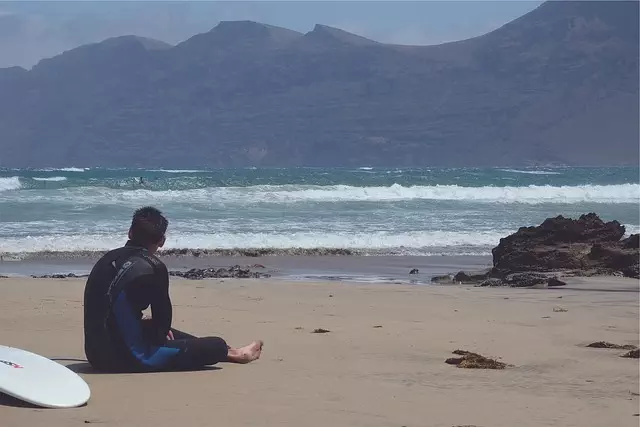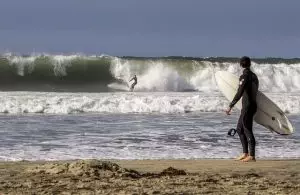For beginner surfers, choosing a surfboard that offers stability, ease of handling, and forgiveness is essential for an enjoyable and progressive learning experience. A surfboard designed for novices should be buoyant, user-friendly, and capable of smoothing out the natural challenges encountered by those new to the sport. Longboards are a great option due to their increased length and width, which aid in both paddling efficiency and standing balance on the board. Softboards or foamies are also recommended for their high buoyancy and safety features that reduce the risk of injury during common novice wipeouts. As learners advance, the skills they develop with these beginner-friendly boards can easily transfer to more sophisticated equipment, ensuring a smooth transition to more advanced surfing techniques. In summary, a surfboard tailored for beginners should be stable, efficient, and adaptable, offering a solid foundation for anyone starting their surfing journey.
Embarking on the journey of learning to surf often hinges on selecting the right surfboard shape, a crucial factor that can influence both progression and enjoyment. This article navigates through the diverse array of board designs tailored for beginner surfers, offering insights into their advantages and how they cater to various wave conditions. From the versatile Mini Malibu to the compact Fish design and the accessible Softboards, each shape serves a distinct purpose in the budding surfer’s quest to master the waves. We’ll explore the evolution of surfboard designs, compare longboards with shortboards, and highlight the top 5 beginner-friendly shapes that will elevate your performance and enrich your surfing experience. Whether you’re an absolute beginner or looking to refine your skills, understanding the nuances of board shape is key to unlocking the full potential of this exhilarating sport.
Understanding the Importance of Board Shape for Beginner Surfers

For beginner surfers, selecting the appropriate surfboard shape is a critical step in their journey into the world of waves. A surfboard designed for novices typically features a larger and more buoyant design, which ensures stability and floatation as they navigate the initial stages of learning. This buoyancy allows beginners to paddle effectively into waves without feeling overwhelmed or underpowered. The width and thickness of a beginner’s surfboard are essential for providing the necessary support and balance, crucial factors when mastering the basics on the board. Additionally, a softer tail and rails can reduce the likelihood of injury should contact with the board occur during a wipeout, which is a common experience for those new to surfing.
Choosing a surfboard that suits a beginner’s skill level can significantly impact their progression and enjoyment of the sport. A longboard or a soft top surfboard for beginners is often recommended due to their forgiving nature and ease of use. These boards offer a longer waterline, which translates into better glide on the wave, and their single fin setup or multiple fin configurations (often referred to as thrusters) provide a stable platform for learning proper wave-catching techniques. The right surfboard for beginners can make all the difference in developing confidence and skill, setting a solid foundation for future advancements in wave riding abilities.
The Evolution of Surfboard Designs: A Guide for Novices

surfboards have undergone a remarkable evolution over the years, transitioning from simple planks to sophisticated pieces of sports equipment. For those new to the sport, selecting the right surfboard can be both exciting and daunting due to the variety of designs available today. The modern era of surfing offers a plethora of board shapes and sizes, each tailored to suit different types of waves, skill levels, and riding styles. Traditionally, surfboards were long, heavy, and relatively uniform in shape; however, technological advancements and shifts in surf culture have led to the creation of specialized boards like the mini-malibu or the fish, which are more manageable for beginners and provide greater maneuverability in smaller waves.
When choosing a beginner’s surfboard, it’s crucial to consider factors such as your weight, height, and skill level. Longboards, with their length and buoyancy, offer stability and are ideal for long-distance riding and catching waves easily. Soft-top longboards are particularly recommended for novices due to their safety features and comfortable ride. Shortboards, on the other hand, are designed for quick turns and fast movements but may be challenging for those just starting out. For a balanced experience, a mini-malibu or a fish surfboard might be the best option as they combine elements of both longboards and shortboards. These boards offer the ease of riding a longboard with the ability to perform maneuvers like a shortboard, making them versatile and user-friendly for beginners looking to progress their skills. Whether you’re paddling out for your first wave or fine-tuning your technique, understanding the range of surfboards available is key to selecting a board that will enhance your performance and enjoyment in the water.
Top 5 Surfboard Shapes Ideal for Beginners and Their Advantages

When starting out in the world of surfing, selecting the right surfboard shape is crucial for a beginner’s progress and enjoyment. A well-chosen board can provide stability, ease of paddling, and the necessary floatation to confidently navigate small waves. Among the top 5 surfboard shapes ideal for beginners, the Longboard stands out for its length, buoyancy, and paddle power, making it a popular choice for those just starting to learn. Its larger deck offers ample space to comfortably find their footing, while the long, drawn-out design enhances glide and smooths out the ride over waves.
Another excellent option is the Softboard, specifically designed with a softer core to reduce injury risk when falling. Its wide outline and rounded rails provide balance and are less prone to cause injury compared to hardboards. Softboards are typically lightweight and have a larger volume, which is perfect for catching waves and maintaining buoyancy in various conditions. For beginners who prefer more maneuverability without compromising on stability, the Mini Malibu is an excellent choice. This board combines elements of both longboards and shortboards, offering a balanced experience that’s forgiving and enjoyable as skills develop. Additionally, the Fish surfboard is a great option for beginners looking to transition into smaller waves with more performance characteristics. Its narrower template and greater rocker allow for faster acceleration and quicker turns, making it an exciting board once the basics are mastered. Lastly, the hybrid longboard, which incorporates elements of shortboards into its design, offers a middle ground for those who want to progress without losing the stability and ease of use provided by longer boards. Each of these shapes has its advantages, catering to different preferences and learning styles, ensuring that beginners can find a surfboard that suits their needs and accelerates their growth as surfers.
Mini Malibu: The Versatile Choice for Learning Wave Mechanics

When selecting a surfboard for beginners, the Mini Malibu stands out as an exceptional choice for mastering wave mechanics. This classic longboard design offers a broad and stable platform that is ideal for novices looking to grasp the fundamentals of paddling, standing up, and riding waves with confidence. The soft rails of the Mini Malibu provide a forgiving edge for learners who are still acquainting themselves with the ocean’s movements, reducing the likelihood of falls and injuries that can often accompany the initial stages of surfing. Its long, drawn-out shape allows for a smooth ride, which is crucial for understanding how to read and respond to wave shapes and forms. The Mini Malibu’s buoyancy also supports surfers who are still building their strength and balance, ensuring a more enjoyable learning experience that can lead to rapid progression in surfing skills. Its wide tail makes trimming and small turn maneuvers accessible, which helps beginners to intuitively learn the subtle nuances of wave dynamics and board control on a gentle slope. Incorporating a Mini Malibu into one’s early surf training not only accelerates learning but also instills a solid foundation for future advancement in various types of waves and conditions. This makes it a versatile, go-to choice for anyone embarking on the exciting journey of learning to surf.
Softboards: The Gateway to Mastering the Art of Surfing

For those eager to experience the thrill of surfing, a surfboard designed for beginners is an essential starting point. Softboards, also known as foamies, are characterised by their buoyancy and forgiving nature, making them ideal for newcomers to the sport. These boards are typically larger and wider than traditional hardboards, providing a stable platform that allows learners to gain confidence and master the basics without the immediate pressure of performance or balance that harder boards demand. The soft core of these surfboards ensures a softer landing when wipeouts occur, which is a common occurrence for beginners. This aspect not only enhances safety but also minimizes frustration, allowing for a more enjoyable learning experience. As one progresses beyond the initial stages, the skills honed on a softboard can smoothly transition to more advanced boards, reflecting the softboard’s role as a gateway to mastering the art of surfing. It’s not just about the board; it’s about finding the right tool that complements one’s learning curve and fosters a love for the sport that lasts a lifetime. Softboards serve this purpose exceptionally well, making them a top choice among surf schools and instructors who prioritize safety and progression in their teaching methods.
Fish Designs: A Compact, Maneuverable Option for Beginner Surfers

For those embarking on their surfing journey, selecting the right surfboard is paramount to a successful and enjoyable experience. A surfboard designed for beginners should be both user-friendly and versatile, capable of adapting to various conditions and providing stability as the surfer learns the ropes. Fish designs are an excellent choice for novices, offering a compact and maneuverable alternative to traditional longboards. These boards are shorter and narrower, making them more responsive and easier to handle in smaller waves. The fish shape is characterized by its pointed nose and slightly wider tail, which allows for smooth turns and quick adjustments on the wave face. This design also tends to have a flatter rocker, meaning the curve of the board from nose to tail is less pronounced, facilitating paddling efficiency and speed. For beginners particularly, a fish surfboard’s forgiving nature and ease of handling can significantly accelerate skill development, making it a top recommendation for those looking to catch their first waves with confidence.
Longboard vs. Shortboard: Comparing Shapes for Different Surfing Styles and Conditions

When selecting a surfboard, the shape and size are critical factors that can influence both the learning curve and the performance in various surfing conditions. For beginners, a surfboard that offers stability, paddling power, and forgiveness is paramount. Longboards, with their greater length and width, provide a more stable platform, making them ideal for those just starting out. Their long, drawn-out outline and single fin or thruster fin setup allow for smooth gliding on gentle waves, offering a gentler learning experience as the rider transitions from lying on the board to standing up. Longboards are versatile and can handle smaller, less powerful waves with ease, making them suitable for a wide range of conditions and surfing abilities.
Conversely, shortboards are designed for more experienced surfers who seek to maneuver in tighter spaces and ride faster, more responsive turns. Typically, these boards are shorter and narrower, providing greater maneuverability and allowing for sharp, quick movements on the wave. Shortboards are better suited for larger waves with more power, as they can harness the energy needed to execute advanced tricks and aerial maneuvers. For beginners, however, a shortboard might be less forgiving and harder to paddle into waves, which is why they are often recommended once the surfer has gained confidence and improved their skills. Both longboards and shortboards have their merits, and the choice between them should be based on the surfer’s style, the prevailing conditions, and their proficiency level. A surfboard for beginners should strike a balance between ease of use and the potential to grow with the rider’s skill set, making both longboard and shortboard designs valuable in different contexts.
